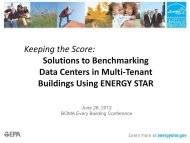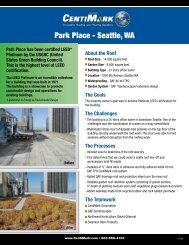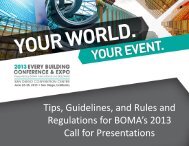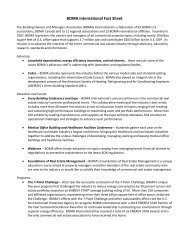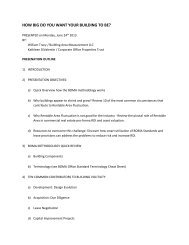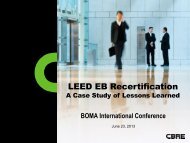Office Standard - BOMA
Office Standard - BOMA
Office Standard - BOMA
Create successful ePaper yourself
Turn your PDF publications into a flip-book with our unique Google optimized e-Paper software.
Applying the<br />
New <strong>BOMA</strong> <strong>Standard</strong>s to<br />
Boost Property Value<br />
William B. Tracy, MBA, NCARB
Copyrighted Materials<br />
> This Presentation is protected by US and<br />
International copyright laws. Reproduction,<br />
distribution, display and use of the presentation<br />
without written permission of <strong>BOMA</strong> International<br />
is prohibited<br />
> Copyright © 2010 by <strong>BOMA</strong> International, All<br />
rights reserved
Learning Objectives<br />
> Understand the Role of Measurement <strong>Standard</strong>s<br />
How they came to be<br />
Role in Real Estate Market<br />
Impact on Asset Value<br />
> Know the <strong>BOMA</strong> Family of <strong>Standard</strong>s<br />
When to Apply Each <strong>Standard</strong><br />
Distinguishing Features<br />
Key Concepts<br />
Terminology<br />
> Discover <strong>BOMA</strong> <strong>Standard</strong> Tricks and Traps
The Good Old Days
Today in Europe<br />
> Meter is official<br />
linear measure<br />
> Most EU countries<br />
have legal building<br />
measurement<br />
standards<br />
> Uniform basis for<br />
valuation, leasing,<br />
taxation and codes
Building Measurement Practices in<br />
North America<br />
Bldg.<br />
Codes<br />
Cost<br />
Estimating<br />
Facility<br />
Mgmt.<br />
<strong>Office</strong><br />
Space<br />
Local<br />
Tax<br />
Ass’mt<br />
Property<br />
Mgmt.<br />
Appraisal<br />
Leasing<br />
Retail<br />
Space<br />
Residential<br />
Space<br />
Industrial<br />
Space
The Smoot<br />
Plaque on Harvard Bridge<br />
Massachusets, USA<br />
“This plaque is in honor of THE<br />
SMOOT, which joined the<br />
angstrom, meter and light year as<br />
standards of length, when in<br />
October 1958 the span of this<br />
bridge was measured, using the<br />
body of Oliver Reed Smoot, MIT<br />
‘62 and found to be precisely<br />
364.4 smoots and one ear.”<br />
Smoot’s Ear: The Measure of<br />
Humanity by Robert Tavernor
<strong>BOMA</strong> <strong>Standard</strong>s<br />
> American Consensus <strong>Standard</strong>s<br />
Represent most common industry measurement practices<br />
> ANSI Certified<br />
American National <strong>Standard</strong>s Institute<br />
Non-government , private, non-profit organization in New York<br />
Stringent requirements for standards-making process<br />
> Voluntary<br />
There are no U. S. laws requiring use of <strong>BOMA</strong> <strong>Standard</strong>s<br />
> <strong>BOMA</strong> Floor Measurement <strong>Standard</strong>s Committee<br />
Author of <strong>BOMA</strong> <strong>Standard</strong>s<br />
Representatives from across the USA & Canada<br />
Representatives from building owners, property managers, tenants<br />
and other industry professionals<br />
Expertise in management of specific property types<br />
> Up to date<br />
ANSI requires review every 5 years, re-certification every 10 years
Asset Value is direct function of<br />
Square Footage<br />
> Three Basic Appraisal Approaches<br />
1. Replacement Cost Approach<br />
Construction Area X Comparable cost per square foot<br />
2. Comparable Sales Approach<br />
Gross Area X Comparable Sales per square foot<br />
3. Income Approach<br />
Rentable Area X Comparable Rent per square foot<br />
> The Three Most Important Things in Real Estate?<br />
With apologies to William Zeckindorf,<br />
Location, Location, Square Footage!<br />
If you have no square footage, there is no there there!
Measurement <strong>Standard</strong>s Help Make<br />
Real Estate Markets!<br />
Jones Lang LaSalle
The <strong>BOMA</strong> Family of <strong>Standard</strong>s<br />
> The Gross Areas of a Building (2009)<br />
> Industrial Buildings (2012)<br />
> Retail Buildings (2010)<br />
> Multi-unit Residential Buildings (2010)<br />
> <strong>Office</strong> Buildings (2010)<br />
> Mixed-use Buildings (2011)<br />
All <strong>BOMA</strong> standards measure only buildings<br />
Site improvements like on-grade parking, sidewalks, patios,<br />
amphitheatres, garden centers, stock yards and the like are<br />
generally NOT measured by the standards
IFMA/<strong>BOMA</strong> Uniform Approach<br />
> Published in 2007<br />
3-year task force<br />
Facility management<br />
Property management<br />
> Terminology<br />
OSCRE compliant<br />
> Taxonomy<br />
Classes of space<br />
> Clarify<br />
Charts & illustrations<br />
> Foundation for future <strong>BOMA</strong> <strong>Standard</strong>s
The Gross Areas of a Building<br />
> New in 2009<br />
> All Occupancies<br />
> Construction<br />
estimating<br />
> Appraisal<br />
> Leasing<br />
Single tenant buildings
The Gross Areas of a Building<br />
> Uses IFMA/<strong>BOMA</strong><br />
terminology &<br />
concepts<br />
> A foundation for<br />
2010 <strong>Office</strong> standard<br />
2010 Multi-unit<br />
residential standard<br />
2010 Retail standard<br />
2011 Mixed-use<br />
standard<br />
2012 Industrial <strong>Standard</strong>
The Gross Areas of a Building<br />
> Two Methods:<br />
• Construction Gross<br />
(CGA)<br />
Total constructed or<br />
covered area<br />
• Exterior Gross Area<br />
(EGA)<br />
Excludes unenclosed<br />
areas (Balconies, roof<br />
terraces, colonnades,<br />
decks, etc.)<br />
> Omits Voids
Industrial Buildings<br />
> Re-published 2012<br />
> For leasing<br />
Factories<br />
Warehouses<br />
Flex Space<br />
> 51% rule for mixed<br />
occupancy<br />
Except Flex Space<br />
> Rentable area<br />
Coordinated with <strong>BOMA</strong><br />
2010 <strong>Office</strong> <strong>Standard</strong>
Industrial Buildings<br />
> Two Methods:<br />
> A-Exterior Wall<br />
Outside surface of<br />
enclosing wall<br />
Coordinated with <strong>BOMA</strong><br />
Gross <strong>Standard</strong><br />
> B-Drip Line<br />
Edge of roof structure
Retail Buildings<br />
> New in 2010<br />
> For Leasing<br />
Shopping centers<br />
Strip centers<br />
Big box retail<br />
> Uses GLA - Gross<br />
Leasable Area<br />
Not Rentable Area<br />
> Based upon the<br />
Gross standard
Retail Buildings<br />
> GLA includes all<br />
perimeter walls<br />
Walls between tenants<br />
are shared<br />
> Common Areas<br />
Include malls, stairs,<br />
elevators, etc.<br />
Are not allocated to<br />
tenant areas<br />
> Ancillary Areas<br />
Restaurant patio seating,<br />
garden centers, etc.
Multi-unit Residential<br />
> New in 2010<br />
> Residential<br />
Buildings with 4<br />
or more units<br />
Apartments<br />
Condominiums<br />
Common Interest<br />
Communities<br />
> Individual units<br />
> Based upon<br />
Gross <strong>Standard</strong>
Multi-unit Residential<br />
> Two Methods<br />
> A – Gross Unit Area<br />
Outside face of unit<br />
enclosing walls<br />
> B – Net Unit Area<br />
Inside face of unit<br />
enclosing walls
<strong>Office</strong> Buildings<br />
> Updated 2010<br />
> Replaced 1996<br />
version<br />
> New terminology<br />
Service areas<br />
Amenity areas<br />
> Updated concepts<br />
External circulation<br />
Tenant Storage<br />
Enclosure<br />
Mezzanines<br />
Restricted headroom
<strong>Office</strong> Buildings<br />
> Two Methods<br />
Total rentable areas for the<br />
building are identical<br />
> Method A<br />
Legacy Method<br />
Floor-by-floor load factors<br />
> Method B<br />
Single load factor<br />
Load factor is the same on<br />
all floors<br />
Requires Base Building<br />
Circulation
Mixed-Use Properties<br />
> New in 2011<br />
Updated in 2012<br />
> Mix of uses<br />
Residential<br />
<strong>Office</strong><br />
Retail<br />
Industrial<br />
Other<br />
> Ground-level retail<br />
in an office building<br />
Incl. in <strong>Office</strong> <strong>Standard</strong>
Mixed-Use Properties<br />
> Disentangle into a<br />
“virtual building”<br />
for each use<br />
> Allocates Mixed-<br />
Use Common Areas<br />
> Each virtual<br />
building measured<br />
by appropriate<br />
<strong>BOMA</strong> <strong>Standard</strong>
Campus settings<br />
> Groups of buildings under common ownership that<br />
share common assets (campus common area)<br />
Physical plant<br />
Management office<br />
Conference center<br />
Cafeteria<br />
> Identification and allocation of Campus Common<br />
Area<br />
> Will be added as addenda to each <strong>BOMA</strong> <strong>Standard</strong><br />
Included in 2012 <strong>BOMA</strong> Industrial <strong>Standard</strong><br />
Working on <strong>Office</strong> <strong>Standard</strong> Campus Addendum for 2012
The 1996 <strong>BOMA</strong> <strong>Standard</strong><br />
> Still in use!<br />
> Still available<br />
from <strong>BOMA</strong>.org<br />
> Need companion<br />
document<br />
> Terminology &<br />
methods different<br />
from newer<br />
standards
Tips and Tricks<br />
> Due Diligence<br />
> Documentation<br />
> Lease Language<br />
> Unenclosed Areas<br />
> Amenities in Buildings with High Load Factors<br />
> The <strong>Office</strong> <strong>Standard</strong> Method B Advantage
Due Diligence Case Study<br />
> Multi-tenant<br />
office building<br />
Leases cited <strong>BOMA</strong><br />
<strong>Office</strong> <strong>Standard</strong><br />
> Seller claimed<br />
108,000 RSF<br />
> <strong>BOMA</strong> Study<br />
showed 106,000<br />
RSF<br />
Cost: $5,000
Due Diligence Case Study<br />
> Difference<br />
equated to $0.5<br />
Million in<br />
purchase price<br />
> Seller measured<br />
to the outside of<br />
the stone bumps<br />
Not <strong>BOMA</strong> Dominant<br />
Portion!
Documentation Case Study<br />
> Large mixed-use<br />
building<br />
> Competing for<br />
large tenant<br />
Tenant has professional<br />
representative<br />
> Building R/U<br />
Ratio<br />
Question: Why 1.0820?<br />
What comprises Building<br />
Common Area?
Documentation Case Study
Documentation Tools<br />
> Adobe Acrobat<br />
View & measured files<br />
ending in “.pdf”<br />
> Autodesk Design<br />
Review<br />
View & measure files<br />
ending in “.dwf”<br />
and“.dwg”<br />
> AutoCAD WS<br />
View & measure online<br />
AutoCAD files in your<br />
browser - PC or tablet!<br />
AutoCAD WS
Good Documentation will:<br />
> Deflect questions about Rentable Area<br />
Calculations<br />
From sophisticated tenant representatives<br />
From sophisticated tenants<br />
From lease auditors<br />
She/he who has the best documentation wins!<br />
> Preserve Rentable Area<br />
Record of actual measurements, not negotiated rentable area<br />
> Help to qualify your building for <strong>BOMA</strong>-360<br />
Good documentation of Rentable Area is a factor in awarding<br />
<strong>BOMA</strong>-360 designation<br />
A hallmark of superior property management
Lease Language<br />
> When to cite a <strong>BOMA</strong> <strong>Standard</strong> in the lease?<br />
A <strong>BOMA</strong> <strong>Standard</strong> is applicable to your building<br />
You are certain that your measurements confirm to the standard<br />
> Why cite a <strong>BOMA</strong> <strong>Standard</strong> in a lease?<br />
The clearest and most complete methodology available<br />
Incorporates consensus measurement practices<br />
Tolerance & dispute resolution procedure<br />
> How to cite a <strong>BOMA</strong> <strong>Standard</strong> in a lease?<br />
Use the ANSI <strong>Standard</strong> designation and remember to add the<br />
method:<br />
<strong>Office</strong> <strong>Standard</strong>: “ANSI/<strong>BOMA</strong> Z65.1-2010 - Method B”<br />
Industrial <strong>Standard</strong>: ANSI/<strong>BOMA</strong> Z65.2-2012 - Method A”<br />
Gross <strong>Standard</strong>: “ANSI/<strong>BOMA</strong> Z65.3-2009 - EGA”<br />
Residential <strong>Standard</strong>: “ANSI/<strong>BOMA</strong> Z65.4-2010 – Method A”<br />
Retail <strong>Standard</strong>: “ANSI/<strong>BOMA</strong> Z65.5-2010”
Lease Language<br />
> Use the correct terminology in the entire lease<br />
document<br />
<strong>Office</strong> <strong>Standard</strong>: “Rentable Area” and “Occupant Area”<br />
Industrial <strong>Standard</strong>: “Rentable Area” and Occupant Area”<br />
Gross <strong>Standard</strong>: “Exterior Gross Area” or “Construction Gross<br />
Area”<br />
Residential <strong>Standard</strong>: “Gross Unit Area” or “Net Unit Area”<br />
Retail <strong>Standard</strong>: “Gross Leasable Area”<br />
> Most standard lease forms already incorporate<br />
the correct terminology<br />
Exception 1: An office lease for a single tenant occupying an entire<br />
building. You need to replace “Rentable Area” with “Exterior<br />
Gross Area”<br />
Exception 2: In office and industrial leases, replace “Usable Area”<br />
(if mentioned) with “Occupant Area”
Unenclosed Areas in the<br />
<strong>BOMA</strong> 2010 <strong>Office</strong> <strong>Standard</strong><br />
External Circulation<br />
Loading Docks<br />
Trash Area<br />
Parking Elevator Lobby<br />
Exterior Door Set-back
External Circulation
External Circulation
Loading Dock
Trash Area
Trash Area and Loading Dock
Parking Elevator Lobby
Exterior Door Set-backs
Amenities and High Load Factors<br />
Health Club<br />
Auditorium
Amenities and High Load Factors<br />
In building with high load factors, reclassifying amenities to occupant area<br />
(and charging for their use) is a better strategy than capping the load factor
The <strong>BOMA</strong> <strong>Office</strong> Method B Advantage<br />
> Method A calculate load factors floor-by-floor<br />
On floors with less occupant area the load factor is higher<br />
Large building service areas, upper atria and exterior set-backs can<br />
reduce occupant areas on some floors<br />
Floors with high load factors may be a problem to lease<br />
> Method B calculates a single load factor for all<br />
floors of a building<br />
The load factor is the same on all floors of a building regardless of<br />
the amount of occupant area on a floor.<br />
A leasing advantage, but is that all?<br />
> Method A and B Both allow capping of load<br />
factors<br />
In Method A, the cap can solve the problem of a high load factor on<br />
particular floors without loss of rentable area on other floors<br />
In Method B, the cap impacts all floors of a building equally
The <strong>BOMA</strong> <strong>Office</strong> Method B Advantage<br />
640<br />
RSF lost<br />
390<br />
RSF lost<br />
1,030 RSF gained
Thank You!<br />
<strong>BOMA</strong> <strong>Standard</strong>s available at www.<strong>BOMA</strong>.org<br />
Links to Official Interpreters<br />
More help available at<br />
www.BuildingAreaMeasurement.com



